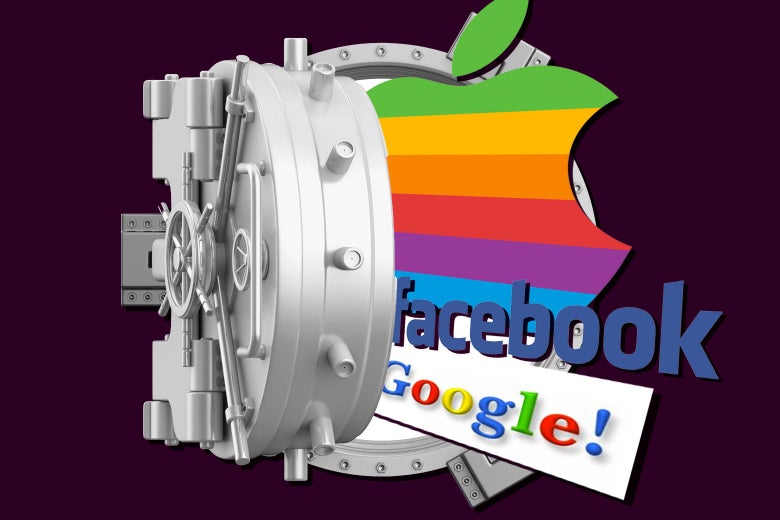Photo illustration by Slate. Photo by Getty Images Plus.
Apple has long been revered for the clean, minimal style of its products and for its slick press conferences and ads. But take a look at its website from back in 1994 and you’ll see a different Apple. Back then, the company still used a rainbow version of its iconic Apple logo, and the colors streak across the page into menu options, which include a mysterious link to something called “Smorgasbord.” By today’s design standards, it’s an eyesore.
You can view this and other snapshots documenting the evolution of Apple’s website, as well as its operating system, through a digital archive called the Version Museum. The site also offers a look at the evolution of other technologies, like the sites of tech giants Facebook and Amazon, apps like Microsoft Word and Internet Explorer, and popular games like Mario Kart and Grand Theft Auto. Each entry includes snapshots of each technology alongside the year those visuals represent.
Alex, who launched the site with his son in May, says the project started as a hobby. (The son is about to start high school, and given his age, the duo wishes to remain anonymous.) “I have really fond memories of a lot of the early versions of these technologies, and I think that when people use computers and websites or play video games these days, they don’t realize that we’ve been on a decadeslong journey to get to where we are today,” he says. “The main purpose of the site is that we want to educate people of what came before what we have now.”
For full commitment to viewing sites in original formats, perhaps they should be opened in Netscape Navigator.
For folks who have grown up alongside Google, Apple, Microsoft, and Facebook, it’s easy to forget how these technologies originally looked. For younger generations who never used these earliest versions, it’s a window into the internet-of-yore they never experienced. Alex’s son, a digital native, has been surprised by some of the earliest versions of the tech he uses regularly. “His mind is blown that things seem so basic compared to today,” says Alex. “He gets a real kick out of it.”
Beyond teens’ amusement or adults’ nostalgia at these decades-old designs, they serve an important role: preserving digital worlds that might otherwise be lost as sites and software update their looks. The nonprofit Internet Archive preserves sites through its Wayback Machine, and librarians, historians, and archivists are building their own records, but it’s impossible to preserve everything—and so what hobbyist archivists like Alex and his son gather may include glimpses into the past that no formal archive does. Part of the Version Museum’s work is identifying old renderings of these technologies, which, Alex says, sometimes come from other hobbyists, like old-school Apple fans’ blogs.
Even if what these hobbyists feature might exist in other archives, the way in which they’ve displayed them—on blogs and websites—makes them more accessible to the casual browser than the same information would be if it were hidden deep inside a library’s archive. For instance, searching the Library of Congress’ web archives for “Facebook” brings up about 20 seemingly random Facebook pages from the 2010s (the Great War Doughboy Search: Tucson and WWI, Deepwater Horizon Response, and Pope Benedict XVI, among others), followed by irrelevant ones (SB Nation blogs before they belonged to SB Nation, like Duke Basketball Report’s site from 2002, which looks strikingly similar to the AOL site I made as a teenager).
What future researchers might want to know from the design of early Facebook or Google is an open question, but having points of comparison easily available could be a boon for that work. I asked Alex if he noticed any design trends, and he emphasizes that he’s not a designer but has noticed more cohesion over time. “During the early internet era, the Jurassic days of the web, the proto-internet era, it was the Wild West,” he says. “You see an amazing explosion of creativity from the ’90s and early 2000s, and then, in my mind, a lot of it converged into a more common [user interface] approach: There are now accepted design principles around navigation.” Whereas the 1990s saw a lot of 3D imagery and buttons to emulate what you might see in the real world, that’s fallen out of favor. Take, for instance, the old Google logos, which started as 3D lettering, transitioned to a typeface with a 3D “shadow” effect, and, in the 2010s, finally transitioned to a “flat” lettering (sans shadow).
In creating the Version Museum, Alex and his son ran into a problem many digital preservationists are contending with: how to ensure faithful representation of the original artifact. In some cases, librarians worry about the medium through which artifacts are preserved; this paper from 2006, for instance, warns that CD-ROMs “may completely be phased out,” and that prediction was right. Just as you need a Nintendo 64 to play Mario Kart 64 or a VCR to play a VHS tape, you need the right computer programs to run old files. Luckily, modern computers can display sites (or pictures of those sites) from back in the day, but that presents a different problem: Our current technology is often too good for how these same websites originally looked. “When you show a version of Yahoo from 1997 on our retina displays, you want to try to be as authentic as possible to the time period,” says Alex. “You need to be careful they’re not rendered too nicely.” To that end, Alex has an old monitor he uses, which he estimates is from the mid-2000s. (For full commitment to viewing sites in original formats, perhaps they should be opened in Netscape Navigator.)
Since the Version Museum launched, Alex says he and his son have received positive feedback from new fans as well as loads of more suggestions for sites to archive. While Alex sees the value of the digital museum as an archival tool, it seems the duo intends to keep it at a hobbyist level, at last for now. “I don’t know that we necessarily have a serious point of view in terms of where we sit in the preservation realm,” says Alex. “Maybe someday if we build up our content enough, we’d be viewed as a place where people could learn about all sorts of different tech, beyond what we’re covering now, but we’re just one small cog in a wheel, doing our part to help preserve this amazing technology landscape.”
Future Tense
is a partnership of
Slate,
New America, and
Arizona State University
that examines emerging technologies, public policy, and society.

















